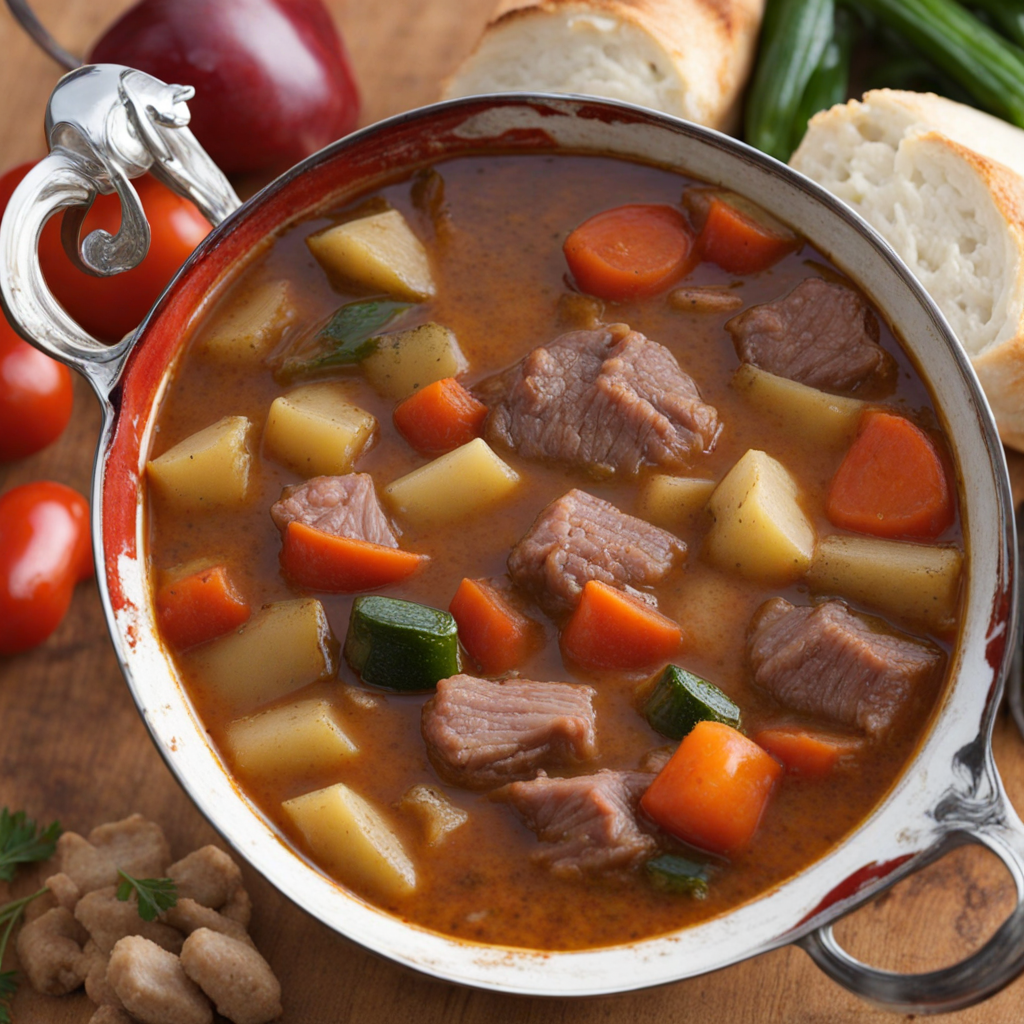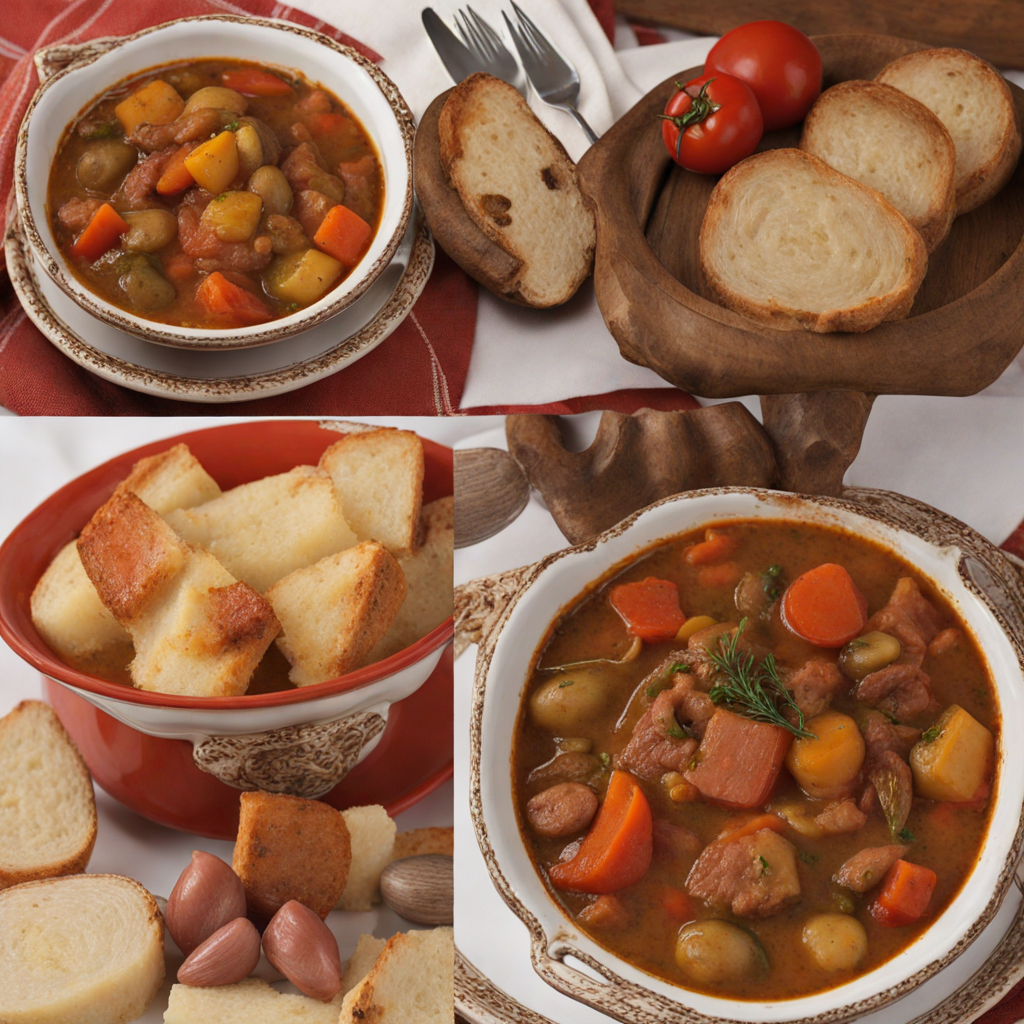Cozido à Portuguesa
Cozido à Portuguesa is a traditional Portuguese stew that embodies the rich culinary heritage of the country, showcasing its agrarian roots and the diversity of regional ingredients. The dish has its origins in the rural kitchens of Portugal, where families would prepare hearty meals using locally sourced meats and vegetables. Historically, cozido was a communal dish, often prepared on special occasions or during winter months when hearty fare was necessary. Its legacy is closely tied to the Portuguese way of life, reflecting a philosophy of utilizing available resources to create nourishing and satisfying meals. The flavor profile of Cozido à Portuguesa is a harmonious blend of savory, earthy, and aromatic notes. The slow cooking process allows the ingredients to meld together, creating a rich broth that is both comforting and satisfying. The primary flavors come from the variety of meats used, which can include beef, pork, and chicken, each contributing its unique taste to the stew. The addition of smoked sausage, such as chouriço and morcela, infuses the dish with a delightful smokiness, while the vegetables add freshness and natural sweetness. The dish is often seasoned with traditional spices like paprika, bay leaves, and pepper, enhancing the overall depth of flavor. Preparation of Cozido à Portuguesa is a labor of love, often taking several hours to complete. The process begins with the selection of ingredients, which typically includes cuts of meat like beef shank, pork shoulder, and chicken thighs, as well as a variety of vegetables such as potatoes, carrots, cabbage
How It Became This Dish
The History of Cozido à Portuguesa: A Culinary Journey Through Time Cozido à Portuguesa, a hearty and rustic dish that epitomizes Portuguese cuisine, is much more than a mere meal; it is a celebratory reflection of the country's rich cultural tapestry. This traditional boiled meat dish, brimming with flavors and textures, has roots that dig deep into Portugal's agricultural history and social customs, making it a staple in family gatherings, festive occasions, and communal feasts. #### Origins: A Culinary Tradition The origins of Cozido à Portuguesa can be traced back to the Middle Ages, a period characterized by the integration of diverse cultural influences in the Iberian Peninsula. The dish is believed to have evolved from the ancient practice of boiling meats and vegetables together, a method that not only maximized flavor but also utilized available resources efficiently. Evidence suggests that similar dishes existed in various forms across Europe; however, Portugal's unique ingredients and cooking techniques have transformed it into a distinct national dish. Historically, the Portuguese diet was heavily influenced by the agrarian lifestyle, where rural communities relied on locally sourced ingredients. Cozido à Portuguesa reflects this ethos, showcasing the bounty of the land: various cuts of meat, sausages, and an array of vegetables such as potatoes, carrots, turnips, and cabbage. The dish is often prepared in a large pot, symbolizing communal cooking practices and the importance of sharing meals with family and friends. #### Cultural Significance: More Than Just a Meal Cozido à Portuguesa is deeply embedded in Portuguese culture and identity. It serves as a culinary emblem of togetherness, often enjoyed during significant gatherings such as Sunday family meals, weddings, and religious celebrations. The communal aspect of preparing and sharing the dish reinforces familial bonds and social ties. In many households, the preparation of Cozido is a ritualistic affair, where family members come together to chop vegetables, season meats, and share stories, reinforcing the importance of culinary traditions passed down from generation to generation. The dish's significance extends beyond familial circles; it is also a representation of regional pride. Different regions of Portugal boast their own variations of Cozido, each with its local twists and ingredients. For instance, in the northern regions, one might find the inclusion of local sausages like "chouriço" and "morcela," while in the Alentejo region, the dish may be enriched with more robust flavors from the region's agricultural produce. This regional diversity highlights the adaptability of Cozido à Portuguesa and its capacity to reflect local identities within the broader Portuguese culinary landscape. #### Development Over Time: From Rustic Roots to Culinary Prestige As Portugal evolved through the ages, so too did Cozido à Portuguesa. The dish has transformed from a simple, rustic preparation into a culinary symbol celebrated in modern gastronomy. In the 19th century, as the Portuguese middle class began to flourish, the appreciation for traditional dishes like Cozido grew, leading to its inclusion in cookbooks and culinary literature. This period marked a pivotal moment where home-cooked meals gained prestige, elevating the status of traditional recipes. In contemporary Portugal, Cozido à Portuguesa has found its way into restaurants and bistros, where chefs honor the original recipe while experimenting with modern techniques and presentations. The dish is often featured on special occasions and is a favorite among tourists seeking an authentic taste of Portuguese culture. The emphasis on quality ingredients and traditional cooking methods aligns with the broader movement toward slow food and sustainable eating, allowing Cozido to retain its authenticity in a fast-paced world. Additionally, the dish has become associated with regional festivals and cultural events, where local chefs compete to create the best version of Cozido. Such competitions not only celebrate culinary excellence but also reinforce the dish's significance as a cultural artifact, bridging the gap between tradition and contemporary dining. #### Cozido à Portuguesa: A Recipe for Connection At its core, Cozido à Portuguesa is a celebration of the land and community. The preparation process, which often takes several hours, fosters a sense of patience and mindfulness that is often lost in modern cooking. The act of boiling various meats and vegetables together allows the flavors to meld harmoniously, creating a rich, savory broth that is as nourishing as it is delicious. The dish can be served as a complete meal or accompanied by rice or bread, providing a versatile base that suits different tastes and preferences. The ingredients used in Cozido à Portuguesa also tell a story of Portugal's agricultural heritage. The inclusion of specific meats, such as beef, pork, and chicken, along with traditional sausages, showcases the country's livestock farming practices. Meanwhile, the use of seasonal vegetables highlights the importance of local produce and the commitment to sustainable food practices. The dish embodies the Portuguese philosophy of utilizing what the land provides, a sentiment that resonates deeply within the culture. #### Conclusion: A Culinary Legacy Cozido à Portuguesa stands as a testament to Portugal's culinary legacy, encapsulating centuries of history, culture, and community spirit. Its ability to adapt while remaining true to its roots allows it to flourish in modern cuisine, bridging the past with the present and ensuring that future generations will continue to savor this beloved dish. Whether enjoyed in a cozy family gathering or a bustling restaurant, Cozido à Portuguesa remains a flavorful reminder of the importance of tradition, connection, and the joy of sharing a meal. In a world where culinary trends can change overnight, Cozido à Portuguesa endures as a symbol of resilience and cultural pride, inviting all who partake in its warmth to experience the heart and soul of Portugal.
You may like
Discover local flavors from Portugal







